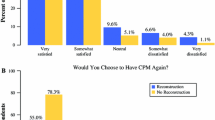Abstract
Background
Decisions regarding the use of surgical procedures for the palliation of symptoms caused by advanced malignancies require the highest level of surgical judgment. Prospective analysis of palliative surgical care may facilitate a more effective and representative evaluation of these patients.
Methods
Patients requiring surgery planned solely for the palliation of an advanced malignancy were offered entry onto this study. Outcome measurements were made before surgery and monthly thereafter until the patient’s death. Accepted techniques of pain assessment, quality of life, and functional status were used.
Results
Between May 1997 and December 1999, 26 patients were enrolled. Although 46% (12 of 26) of patients demonstrated improvement in pain control or quality of life after palliative surgery, these benefits lasted a median of only 3.4 months. Palliative surgery was associated with significant postoperative complications in 35% (9 of 26) patients.
Conclusions
Although many patients had no apparent demonstrable benefit from surgery, surgeons were able to identify a group of patients who experienced significant benefits after a palliative procedure. The relationships between the patient and family members and the surgeon play an important role in decision-making throughout the palliative phase of cancer treatment.
Similar content being viewed by others
References
Miner TJ, Jaques DP, Tavaf-Motamen H, Shriver CD. Decision making on surgical palliation based on patient outcome data.Am J Surg 1999; 177; 150–4.
Butler RN, Burt R, Foley KM, et al. A peaceful death: how to manage pain and provide quality care—a roundtable discussion.Geriatrics 1996; 51: 32–5.
Strian JJ. The evolution of quality of life evaluations in cancer therapy.Oncology 1990; 4: 22–6.
Foley KM. Controlling the pain of cancer.Sci Am 1996; 275: 164–5.
Porzsolt F, Tannock I. Goals of palliative cancer therapy.J Clin Oncol 1993; 11: 378–81.
Lillemoe KD, Pitt HA. Palliation: surgical and otherwise.Cancer 1996; 78: 605–14.
Butler RN, Burt R, Foley KM, et al. Palliative medicine: providing care when cure is not possible—a roundtable discussion.Geriatrics 1996; 51: 33–6.
Marks RM, Sachar EJ. Undertreatment of medical inpatients with narcotic analgesics.Ann Intern Med 1973; 78: 173–81.
Jacox A, Carr DB, Payne R. New clinical practice guidelines for the management of pain in patients with cancer.N Engl J Med 1994; 330: 651–5.
Janjan NA, Martin CG, Payne R, et al. Teaching cancer pain management: durability of educational effects on a role model program.Cancer 1996; 77: 996–1001.
Osoba D. Lessons learned from measuring health-related quality of life in oncology.J Clin Oncol 1994; 12: 608–16.
Fayers PM, Jones DR. Measuring and analyzing the quality of life in cancer clinical trials: a review.Stat Med 1983; 2: 429–46.
Portenoy RK. Pain and quality of life: clinical issues and implications for research.Oncology 1990; 4: 172–8.
Lo B. Improving care near the end of life: why is it so hard?JAMA 1995; 274: 1634–6.
Cella DF, Tursky DS, Gray G, et al. The Functional Assessment of Cancer Therapy scale: development and validation of the general measure.J Clin Oncol 1993; 11: 570–9.
Fishman B, Pasternak S, Wallenstein SL, et al. The Memorial Pain Assessment Card: a valid instrument for the evaluation of cancer pain.Cancer 1987; 60: 1151–8.
Pratt RB. Comprehensive assessment of the patient with cancer pain. In:Cancer Pain. Philadelphia: Lippincott, 1993: 23–41.
DeConno F, Caraceni A, Gamba A, et al. Pain measurement in cancer patients: a comparison of six methods.Pain 1994; 5: 161–6.
Schag CC, Heenrich RL, Ganz PA. Karnofsky performance status revisited. Reliability, validity and guidelines.J Clin Oncol 1984; 2: 187–93.
World Health Organization.Cancer Pain Relief and Palliative Care: Report of a WHO Expert Committee (Technical Report Series No. 804). Geneva: World Health Organization, 1990: 11.
Ball AB, Baum M, Breach NM, et al. Surgical palliation. In: Derek D, Hanks GWC, MacDonald N, eds.Oxford Textbook of Palliative Medicine. Oxford, England: Oxford Press, 1998: 282–97.
Forbes JF. Palliative surgery in cancer patients: principles and potential of palliative surgery in patients with advanced cancer.Recent Results Cancer Res 1988; 108: 134–42.
Krouse RS, Nelson RA, Farrell BR, et al. Surgical palliation at a cancer center.Arch Surg 2001; 136: 773–8.
Ashby M, Stoffell B. Therapeutic ratio and defined phases: proposal of ethical framework for palliative care.BMJ 1991; 302: 1322–4.
Birkmeyer JD, Birkmeyer NO. Decision analysis in surgery.Surgery 1996; 120: 7–15.
Henschke UF, Flehinger BJ. Decision theory in cancer therapy.Cancer 1967; 20: 1819–26.
Eisenberg BL. Surgical palliation of upper gastrointestinal cancer.Curr Probl Cancer 1995; 19: 333–76.
Balch CM. The surgeon’s expanded role in cancer care.Cancer 1990; 65: 604–9.
Milch RA, Dunn GP. The surgeon’s role in palliative care.Bull Am Coll Surg 1997; 82: 14–7, 48.
Zelen M. Guidelines for publishing papers on cancer clinical trials: responsibilities of editors and authors.J Clin Oncol 1983; 1: 164–9.
Author information
Authors and Affiliations
Corresponding author
Additional information
The opirions and assertions herein are the private ones of the authors and are not to be construed as official policy or reflecting the views of the Department of Defense.
Rights and permissions
About this article
Cite this article
Miner, T.J., Jaques, D.P. & Shriver, C.D. A prospective evaluation of patients undergoing surgery for the palliation of an advanced malignancy. Annals of Surgical Oncology 9, 696–703 (2002). https://doi.org/10.1007/BF02574487
Received:
Accepted:
Issue Date:
DOI: https://doi.org/10.1007/BF02574487




